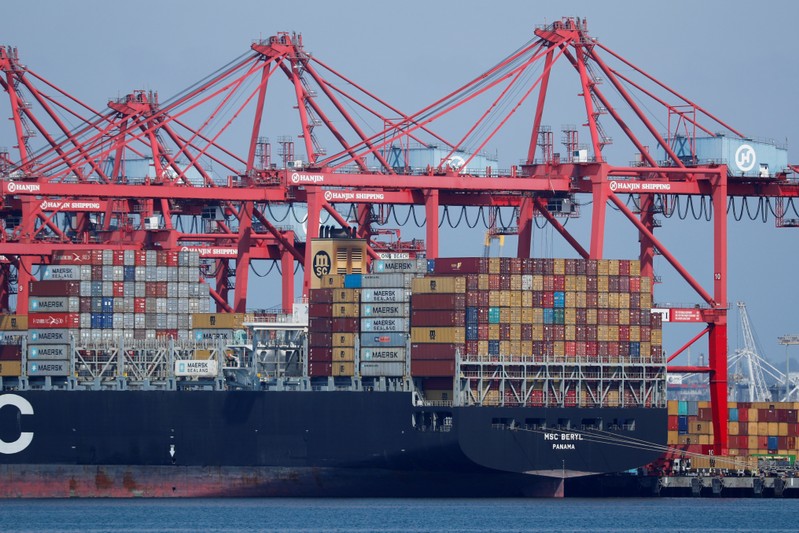
A container ship is shown at port in Long Beach, California, U.S. July 16, 2018. REUTERS/Mike Blake
August 14, 2018
By Lucia Mutikani
WASHINGTON (Reuters) – U.S. import prices were unchanged in July as a surge in the cost of fuels was offset by weak prices elsewhere, suggesting that a strong dollar was keeping imported inflation in check.
The Labor Department said on Tuesday the flat reading in import prices last month followed an upwardly revised 0.1 percent drop in June. Import prices were previously reported to have declined 0.4 percent in June.
“The U.S. is no longer importing disinflation,” said Ryan Sweet, a senior economist at Moody’s Analytics in West Chester, Pennsylvania. “However, growth in import prices will be limited by the recent appreciation in the U.S. dollar, which affects nonfuel import prices with a lag.”
Economists polled by Reuters had forecast import prices gaining 0.1 percent in July. In the 12 months through July, import prices rose 4.8 percent, the largest gain since February 2012, after increasing 4.7 percent in June.
Last month, prices for imported fuels and lubricants jumped 1.6 percent after rising 1.3 percent in June. Food prices dropped 1.8 percent after declining 2.6 percent in June. Excluding fuels and food, import prices slipped 0.1 percent in July after falling 0.2 percent in the prior month.
The so-called core import prices increased 1.6 percent in the 12 months through July.
The dollar gained 0.5 percent versus the currencies of the United States’ main trading partners in July and has strengthened more than 4 percent on a trade-weighted basis so far this year. This could temper the anticipated increases in the prices of some imported goods as a result of trade tensions between the United States and other major economies.
The Trump administration has imposed tariffs on steel and aluminum imports to protect domestic industries from what it says is unfair foreign competition. Major trading partners, including the European Union, China, Mexico and Canada have responded similarly with tariffs of their own.
EXPORT PRICES FALL
Washington has also slapped import duties on Canadian lumber as well as a range of consumer goods from China. While import prices exclude duties, economists say the tariffs will soon show up in producer and consumer prices.
“It’s early yet in the trade wars battle, and more inflation from higher-priced imported goods may still be on the way,” said Chris Rupkey, chief economist at MUFG in New York.
In July, import prices for nonfuel industrial supplies and materials tumbled 1.0 percent, the biggest monthly drop since January 2016, after rising 0.2 percent in June.
The cost of imported capital goods dipped 0.1 percent for a second straight month in July. Imported motor vehicle prices were unchanged. The cost of consumer goods excluding automobiles rose 0.3 percent, reversing June’s 0.3 percent drop.
Prices of goods imported from China fell 0.2 percent in July, the first drop in 10 months, after edging up 0.1 percent in June. The cost of Chinese imports rose 0.2 percent in the 12 months through July after increasing 0.5 percent in June.
Though tariffs are excluded from import prices, they are having an impact on the value of U.S. exports. Export prices dropped 0.5 percent in July, the biggest decline in 14 months, after rising 0.2 percent in June.
Export prices for agricultural products tumbled 5.3 percent last month, the largest decline since October 2011, weighed down by a 14.1 percent plunge in soybean prices.
China’s retaliatory tariffs on U.S. soybeans have driven down prices in recent months. There were also declines in the prices for corn, wheat, fruits and nuts in July.
Export prices increased 4.3 percent on a year-on-year basis in July after rising 5.3 percent in June. Agricultural prices fell 2.0 percent in the 12 months to July, the first annual decrease in a year, after increasing 5.3 percent in June.
“The impact of tariffs on agricultural commodity prices from the trade disputes is showing through,” said John Ryding, chief economist at RDQ Economics in New York.
Prices for nonagricultural exports were unchanged in July 2017 after rising 0.4 percent in June.
(Reporting By Lucia Mutikani; Editing by Andrea Ricci)

